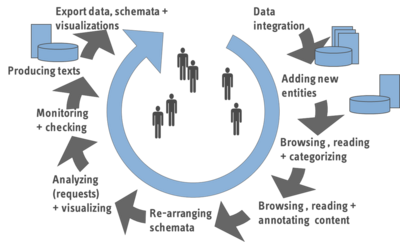Semantic CorA for Researchers: Unterschied zwischen den Versionen
Anna (Diskussion | Beiträge) |
Anna (Diskussion | Beiträge) |
||
| Zeile 3: | Zeile 3: | ||
[[File:Capacities_Cycle.png|right|thumb|400px|Capacities for Research]] | [[File:Capacities_Cycle.png|right|thumb|400px|Capacities for Research]] | ||
==Importing Research Data== | ==Importing Research Data== | ||
| − | Research objects such as large digitalized corpora are often hosted by a source such as a digital library and have to be imported into the vre. In our use case ("VFU ELF": vre for educational lexika, see [[Technical_Description_Use_Case_VFU-ELF|technical description]] or [[Description Use Case VFU-ELF|description of contents | + | Research objects such as large digitalized corpora are often hosted by a source such as a digital library and have to be imported into the vre. In our use case ("VFU ELF": vre for educational lexika, see [[Technical_Description_Use_Case_VFU-ELF|technical description]] or [[Description Use Case VFU-ELF|description of contents]]) we developed a java-based application which addressing the [http://en.wikipedia.org/wiki/Open_Archives_Initiative_Protocol_for_Metadata_Harvesting OAI-PMH Interface] of the digital library. For each part of the lexicon (lexicon, volume, lemma, image file) a wiki-page was created automatically. For a manual import of further lexica, we developed the extension [[Semantic_CorA_Extensions#OfflineImportLexicon|OfflineImportLexicon]] to enable researchers to design their own corpus. |
==Browsing and Reading== | ==Browsing and Reading== | ||
Version vom 25. November 2014, 15:39 Uhr
The virtual research environment Semantic CorA aims at enhancing research by supporting the research life-cycle. The main capacities of Semantic CorA are described below:
Importing Research Data
Research objects such as large digitalized corpora are often hosted by a source such as a digital library and have to be imported into the vre. In our use case ("VFU ELF": vre for educational lexika, see technical description or description of contents) we developed a java-based application which addressing the OAI-PMH Interface of the digital library. For each part of the lexicon (lexicon, volume, lemma, image file) a wiki-page was created automatically. For a manual import of further lexica, we developed the extension OfflineImportLexicon to enable researchers to design their own corpus.
Browsing and Reading
In addition to data integration, browsing structures and reading options can be realized within the vre. Every entity can be represented as a wiki page, therefore we created templates (a feature of MediaWiki), semantic forms (an extension of SMW) and ask-queries (a feature of SMW) to give a structured presentation and overview of the existing research data and annotations. For our use case (see technical description or description of contents), we created a data sheet and a table of content on each lexicon page.
Enriching Research Objects (Annotating and Coding)
Research objects can be enriched by using different techniques. For one, MediaWiki allows for the categorization of wiki pages by using the wiki-syntax (e.g. category:Person). Moreover, specific annotations can be realized as properties with Semantic MediaWiki. These options are supported by creating of forms to reduce the technical barrier of using the wiki syntax.
For the annotation of images (or text in image files), we developed the extension Semantic Image Annotator which allows the selection and annotation of rectangular areas on images. As the values of the socalled properties can be entities (e.g. wiki pages) themselves, coding and linking of the imported and created research objects leads to a semantic network of entities, created by the researcher.
Analyzing and Visualizing
Based upon the semantic network queries by usage of the SMW Query Language ASK can be formulated and their results can be displayed as tables, maps or bar diagrams.
Data Export, Sharing and Reuse
The newly gained research data should be interoperable and shareable. SMW provides facilities to export query results to non-semantic formats such as JSON and CSV as well as RDF/XML. For export in RDF/XML, some well-known vocabularies like Friend-of-a-Friend (FOAF), the Bibligraphic Ontology (BIBO) or Simple Knowledge Organization System (SKOS) can be imported into the wiki. allowing for ready reuse and integration into other contexts (e.g. Linked Data).

